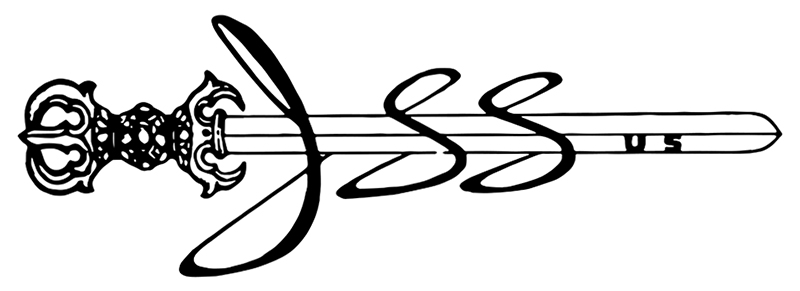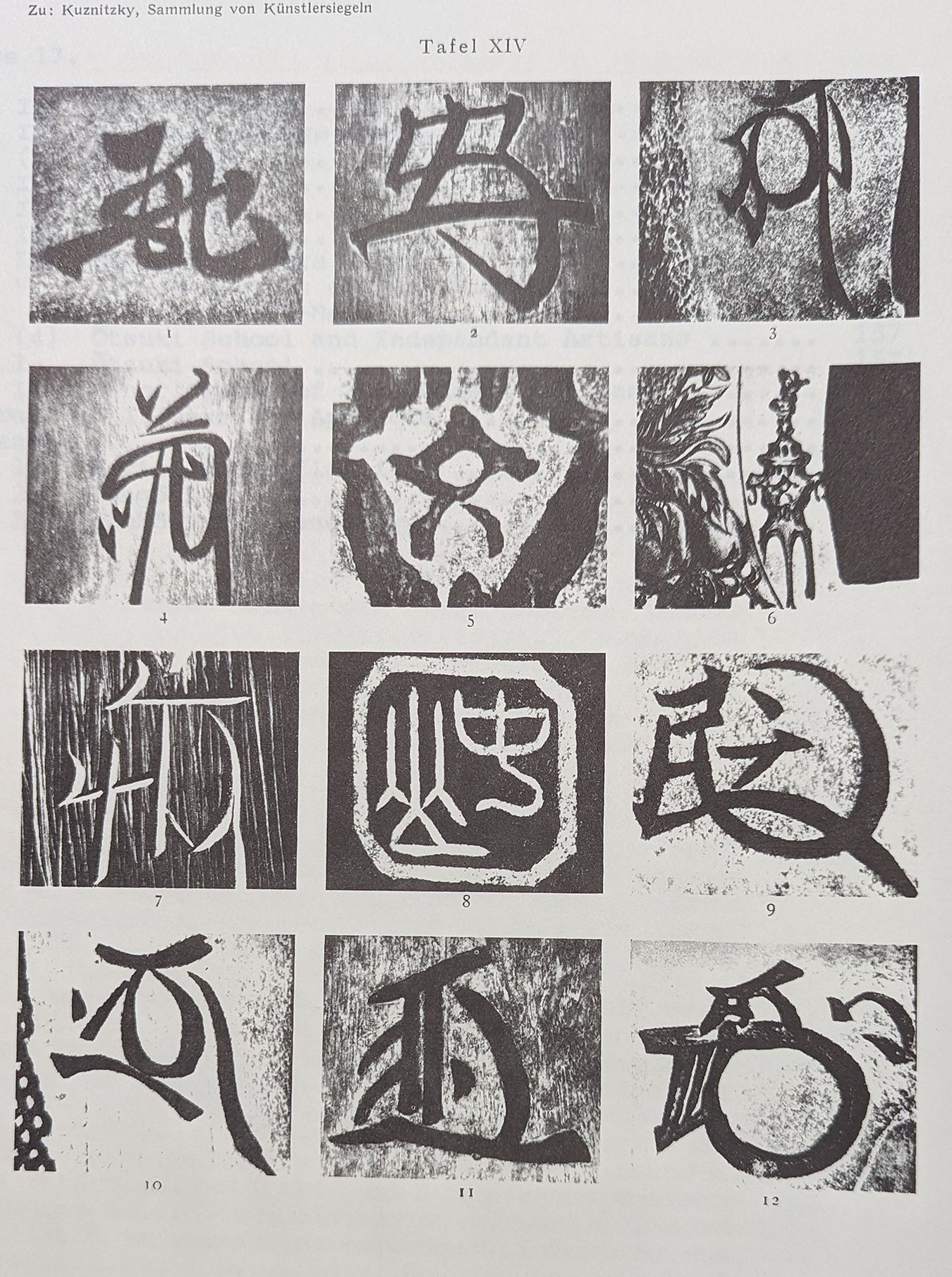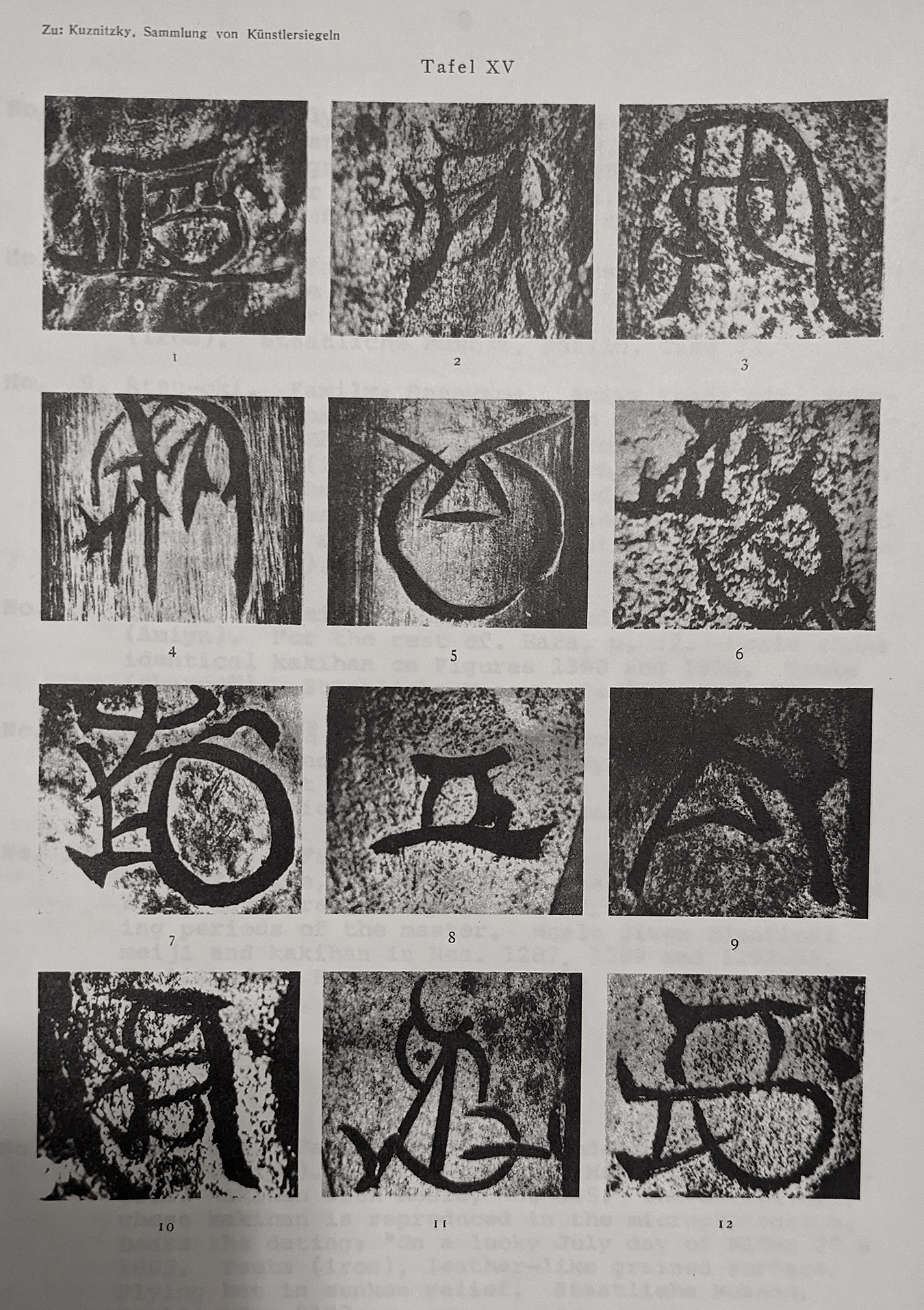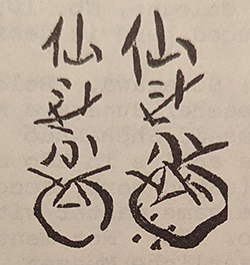
The articles on this page originally appeared in JSSUS newsletter Volume 9, no.1, 1971. Page 7
A Collection of Artists Seals (Han and Kakihan)
in Microphotographic Reproduction
by Martin Kuznitzky, translated from the German by Alan L. Harvie.
A Collection of Artists Seals (Han and Kakihan)
in Microphotographic Reproduction
by Martin Kuznitzky, translated from the German by Alan L. Harvie.

No. 1. Riü-min. Family: Kishizawa (Hara reads: Serizawa). For the rest cf. Hara, p. 164, and Joly, p. 83, No. 29. Manju (shibuichi). Kuznitzky collection.
No. 2. Kuni-chika. Family: Tsuchiya. According to Amiya: student of Yasuchika IV. For the rest cf. Hara, p. 234, under Yasuchika "y", with whom he is identi- cal. According to Amiya, his kakihan, reproduced here, is a modification of the character Yasu. Kozuka (shakudo). Kuznitzky collection.
No. 3. Nori-tada. Family: Goto. Student of Goto Norikiyo, lived in Kanazawa in Kaga Province (Amiya). This guard (iron, Staatliche Museen, Berlin, Case 71), whose kakihan is reproduced in Plate XIV, No. 3, is described by Hara, p. 158. On the guard Noritada has engraved the statement that, along with the guard, he has also prepared a menuki in the form of a dragon (Ryo menuki ichido chiribamu kore). Ac- cording to the dating the guard was finished in the first 10 days of the spring of the year 10 of the Bunsei era (1827).
No. 4. Den-jo. Family: Goto. Student of Goto Takujo. cf. Plate VII, No. 11 and Plate XI, No. 10. Earlier he called himself Uhei and later Kihei. For the rest cf. Hara, p. 10. Kozuka (shakudo). Fahrenhorst collection, No. 67.
No. 5 and No. 6 Hide-oki. Family: Kawarabayashi. Cf. Hara, p. 23. In addition to the names stated there, Amiya also mentions Tangoya #. His han, Plate XIV, No. 6, and No. 5 (the latter reproduction shows the center part micro photographed using a stronger magnification), is interpreted by Amiya as a modification of the character Bun (the beginning of his name Bunriusha). Joly presents a kakihan of this master on p. 14, No. 110. Tsuba (iron). Staatliche Museen, Berlin, Case 74.
No. 7. En-jo. Family: Goto. Died 1784 at the age of 64 (Amiya). Listed by Hara, p. 239, under Yenjö. Mosle, in Figures 241, 246 and 250, shows identical kakihan under the name Mitsutaka. Kozuka (shakudo). Museum fur ostasiatische Kunst, Cologne, No. 10. 7.
No. 8. Mune-nori. Family: Nakayama. Belongs, according to Amiya, to the Tetsugendo School through his teacher Naofusa. For the rest cf. Hara, p. 130. Tsuba (iron). Staatliche Museen, Berlin, Case 72.
No. 9. Atsu-oki. Family: Sasayama. Amiya reads him: Tokuoki. Joly (page 2, No. 36) also gives the name Manundo (Houndo?). For the rest cf. Hara, p. 4. On the guard (iron, Staatl. Museen, Berlin, Case 71), from which the kakihan reproduced here is derived, the artist has engraved the statement that he worked according to a picture by a painter, Joki (cranes in a loyus pool).
No. 10. Ichi-ga. Family: Yamazaki. Student of Goto Shuja (Amiya). For the rest cf. Hara, p. 32. Mosle shows identical kakihan on Figures 1390 and 1396. Tsuba (shakudo). Staatliche Museen, Berlin, Case 71.
No. 11.Nobu-tsugu . Family: Hoshiyori. Of his teacher nothing is known. He lived in Kyoto about 1770 (Amiya). Not mentioned by Hara. Kozuka (iron). The inscription is cursive. Kuznitzky collection.
No. 12. Tsune-nao. Family: Ichinomiya. Joly (page 115, No. 430) exhibits, in addition to the kakihan reproduced here, two more kakihan derived from different work- ing periods of the master. Mosle gives identical meiji and kakihan in Nos. 1287, 1289 and 1292-93. Is listed by Hara under Sadanaka (p. 166). Staatliche Museen, Berlin, Case 71.

No. 1. Mori-tomi. Family: Shoami. Student of Shoami Moriyoshi (Amiya). For the rest cf. Hara, p. 116. Identical kakihan with Mosle, No. 645. The swordguard, whose kakihan is reproduced in the microphotograph, bears the datings "On a lucky July day of Kiowa 2" = 1802. Tsuba (iron), leather-like grained surface. Flying bat in sunken relief. Staatliche Museen, Berlin, No. 2122.
No. 2. Tomo-teru A. Family: Miyake. Belongs to the Iwa- moto School. His teacher was Miyake Fusamitsu (Hara, P. 203: Terumitsu). Tomoteru lived in Tokyo around 1780 (Amiya). Amiya gives him additional artist names: Jiryüken and Kho. For the rest cf. Hara, p. 214. Tauba (iron). Kuznitzky coll.
No. 3. Masa-yoshi. Cf. the somewhat deviating kakihan of Plate XI, No. 9. He gives his residence (cursively inscribed) as Ki no Kuni (K11). Cf. Hara, p. 95. Joly (p. 52, No. 289) also gives a han of this master in addition to the kakihan reproduced here (Plate XV, No. 3). As an additional name he gives Yanagido (according to Kämmel: Yöds). Active around 1800 in Wakayama in Kii (Amiya). Tsuba (iron). Mu- seum für ostasiatische Kunst, Cologne, No. 55a.
No. 4. Sei-jö. Family: Goto. Was (according to Amiya) a student of Goto Ryujo and died 1688 at the age of 83. For the rest cf. Hara, p. 170. Kozuka (shakudo). Museum für ostasiatische Kunst, Cologne, No. 10. 22.
No. 5. Sen-jö. Family: Goto. Died 1692 at the age of 69 (Amiya). For the rest of. Hara, p. 173. Kozuka (shakudo). Museum für ostasiatische Kunst, Cologne, No. 10-31. Note: In the kakihan of Plate V, No. 8, of the same master, Goto Senjo, the three dashes at the upper periphery are components of the character JO of the associated mei. Hence, they do not belong to the picture of this kakihan. One has to think of them as being omitted, which is facilitated by comparison with microphotograph 5 of this Plate XV, and the two meiji and kakihan shown juxtaposed in the text.

It was originally planned to retouch It away these three dashes not belonging to kakihan V, No. 8, however, this intention was abandoned because retouching of the negative in its strict (if actually unjustified) sense could be considered as a fake. On the other hand, microphotograph V, No. 8, was not eliminated because of the interesting punctations whose technical regularity appears to preclude the assumption of an "artifact" by accident.
No. 6. Masa-yoshi E. Family and teacher unknown. According to Amiya he belongs to the Mito School. Was active in Edo around 1840. Not mentioned by Hara. Tsuba (iron). Kuznitzky collection.
No.7. Hide-naga. Family, Takase. Cf. Hara, p. 23. Joly (p. 121, No. 87) brings, in addition to the kakihan here reproduced microphotographically (Plate XV, No. 7), an additional, slightly deviating, kakihan of the same artist (who he reads: Yeijiu). Puchi (shakudo). Museum tar ostasiatische Kunst, Cologne, No. 12.
No. 8. Cho-min. Family: Someya. Cf. Hara, p. 8. Kaga- mibuta (shibuichi). Kuznitzky collection.
No. 9. Masa-tatsu IEM. According to Kämmel, better: Shō- ry. Family relationship unknown. clan names Fuji- wara, title: Ason (Kümmel). Through his teacher, Tsuchiya Seimin (Haras Shamin), he belongs to the Tsuchiya School. Active in Edo about 1830 (Amiya). The inscription of the guard (iron, Kuznitzky collec- tion) is cursive. Amiya reads: Horyusai Masatatsu and gives the transcription: E
No. 10. Nari-toshi. Family: Umetada. His first teacher was Sekigawa Yoshitada, his second: Umetada Nariuke [sic] ea (Amiya). N: Ittöshi (Kümmel). The master was active in Edo about 1760. Hara reads him: Nari- naga (p. 148-149). Joly, who quotes him by the same kakihan which is reproduced here microphotographically (p. 76, No. 208), also gives the inscription: kimi ban zai (long live the Emperor!) which, at the same time, is engraved on this guard (iron, Museum für ostasiatische Kunst, Cologne, No. 10, 38) from which the kakihan reproduced here is derived.
No. 11. Masa-yoshi. Family: Sunagawa. Belongs to the Ito School through his teacher Sunagawa Masachika (Amiya). Also called himself Shohakudo According to Amiya he was active in Edo around 1780. Was still alive in 1831 (dated work, according to Kümmel). Joly quotes the same master with identical kakihan on p. 52 under No. 285. Not mentioned by Hara. Tsuba (iron). Staatliche Museen, Berlin, No. 2346a.
No. 12. So-jo. of his family relationship and teacher nothing is known. Active around 1830 in Edo (Amiya). Not mentioned by Hara. Tsuba (iron). Kuznitzky collection.